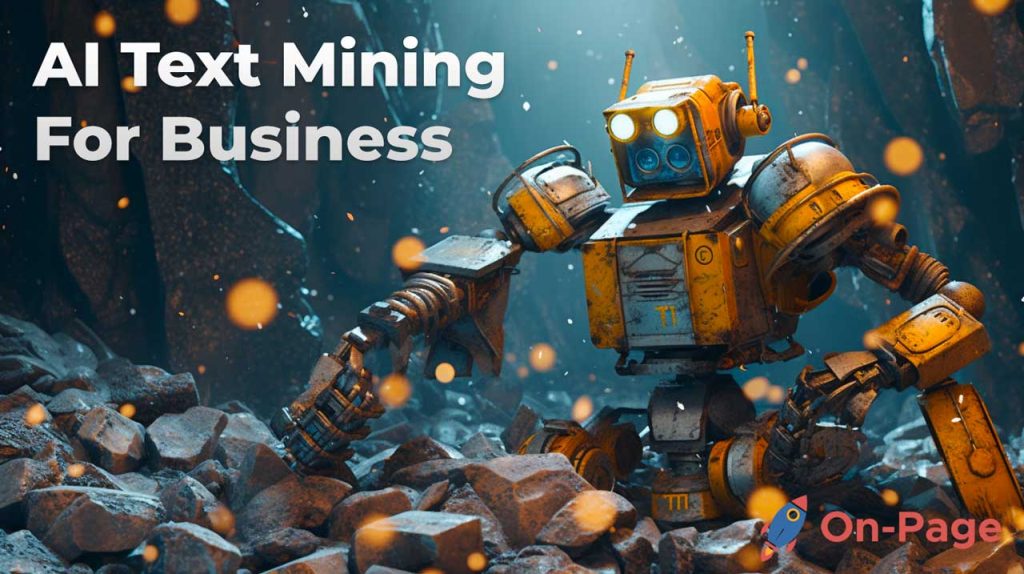Imagine drafting a flawless article or perfecting an engaging blog post in mere seconds. Yes, you read that right! Seconds! What once seemed impossible is now a revolutionary reality thanks to the power of AI writing technology. In this post, we’ll dive into the fascinating world of automated writing and uncover the astonishing benefits that will change the way you create content forever. With On-Page.ai, say goodbye to writer’s block, and embrace your new creative partner – AI Writing. Are you ready to explore?
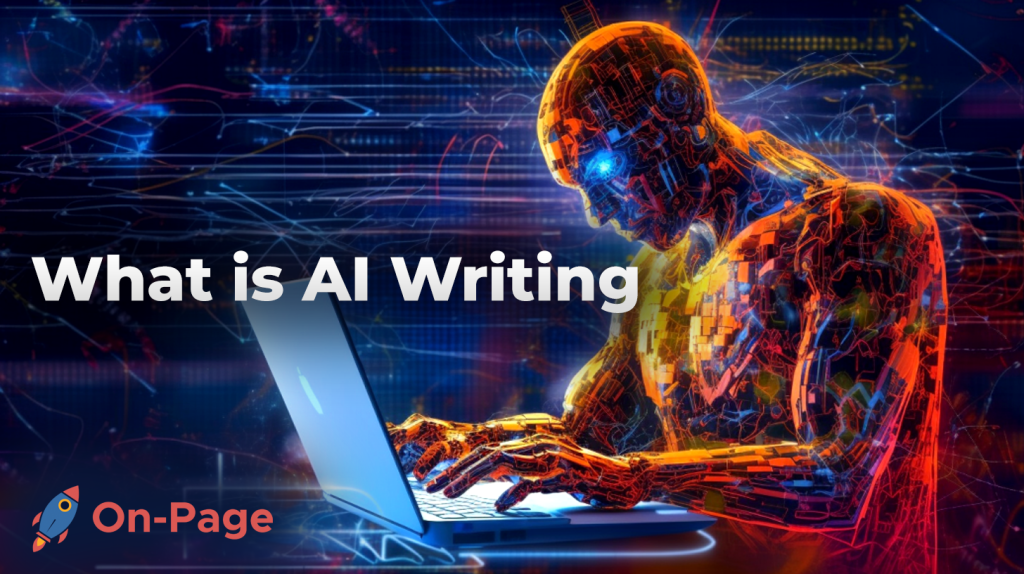
AI writing is the use of artificial intelligence technology to generate human-like text content based on user input. The software utilizes machine learning algorithms to scan existing content and data to analyze patterns, and then creates unique copy that mimics the tone, style, and structure of human writing. AI writing can save time for businesses and individuals who want to produce high-quality content quickly, but it should be used in conjunction with human creativity and editing to ensure accuracy and effectiveness.
Understanding AI Writing Technology
Artificial Intelligence (AI) and Machine Learning (ML) are transforming the way we approach various domains, including writing. AI-powered writing tools are designed to help writers enhance their skills, productivity, and efficiency. AI writing is an automated process that uses advanced natural language processing algorithms and ML models to generate text. Unlike traditional content creation methods that rely on manual research and writing, AI writing technology simplifies the process by automating it.
AI writing technology is a significant breakthrough in the field of content creation since it can produce vast amounts of content within minutes without compromising quality. This technology has a wide range of use cases across different industries, including eCommerce, digital marketing, journalism, and academia.
Despite its advantages, some experts argue that AI writing will replace human writers in the future. However, this proposition is farfetched as AI writing tools still require human intervention to deliver quality results.
Think about AI writing technology as a team of skilled writers who work 24/7 with unmatched speed and accuracy. They have access to vast amounts of data from various sources and formats such as articles, blog posts, social media comments, among others. With this information at their disposal, they can create original content or rewrite existing content while adhering to grammar rules and guidelines for a particular style.
Before diving deeper into how AI generates text, let’s explore some popular AI writing tools available in the market today.
How AI Generates Text
Popular AI writing tools like GPT-3 (Generative Pre-trained Transformer 3), Jarvis.ai, Copy.ai leverage Natural Language Processing (NLP) algorithms that analyze massive amounts of written or spoken text to understand language patterns. By analyzing grammar patterns and language usage across thousands of documents or texts via Machine Learning models like Neural Networks, AI writing technology can generate coherent and natural-sounding text.

AI-powered writing tools generate text through different methods such as the keyword approach, trained models, and sequence prediction. The keyword approach involves inputting keywords related to the topic of interest in the tool, which then generates text based on the keyword meanings while maintaining relevance.
Trained models use past texts to create concepts that can be used to create new content. Sequence prediction models examine language patterns in texts’ sequences to understand language structure and rules – these allow for generating more natural-sounding text.
Think about how a chef uses ingredients to create varying dishes using recipes they have learned over time. They know what ingredients are essential and how much of each is needed for specific dishes; this forms their knowledge base. Similarly, AI writing tools have vast amounts of data that they analyze, breaking them down into meaningful “ingredients” which they then use to generate content pieces.
Some people may argue that AI-generated content lacks creativity, voice, and originality compared to work written by human writers. However, the latest advancement in AI writing technology has elevated these tools beyond simple sentence generators; they are now capable of producing high-quality content comparable to works produced by skilled human writers.
Understanding AI Writing technology is essential since it’s part and parcel with an ever-growing technological revolution that aims to make our work easier and efficient. With various popular tools available in the market today, it is clear that users benefit significantly from its advantages.
Similarly, understanding how AI Generates Text requires in-depth analysis of various NLP algorithms used by popular writing tools. With its advancements thus far in natural-sounding content generation, it goes without saying that AI will continue enhancing itself with better predicting capabilities guaranteeing high-quality material creation continually.
Popular AI Writing Tools
Artificial Intelligence (AI) writing tools are becoming increasingly popular, and many have emerged in recent years. Some of the most popular AI writing tools on the market today include Jasper.ai, Copy.ai, Rytr.me, and Peppertype.ai. Each tool offers unique features that can help users produce high-quality content quickly and efficiently.
Jasper.ai is an AI writing assistant that uses machine learning algorithms to provide personalized feedback for your content. This tool analyzes your text and suggests improvements, including grammatical corrections, sentence structuring, and word choice recommendations. It also has a feature that generates headlines, makes summaries of existing content, and generates questions for you based on your topic or keywords.
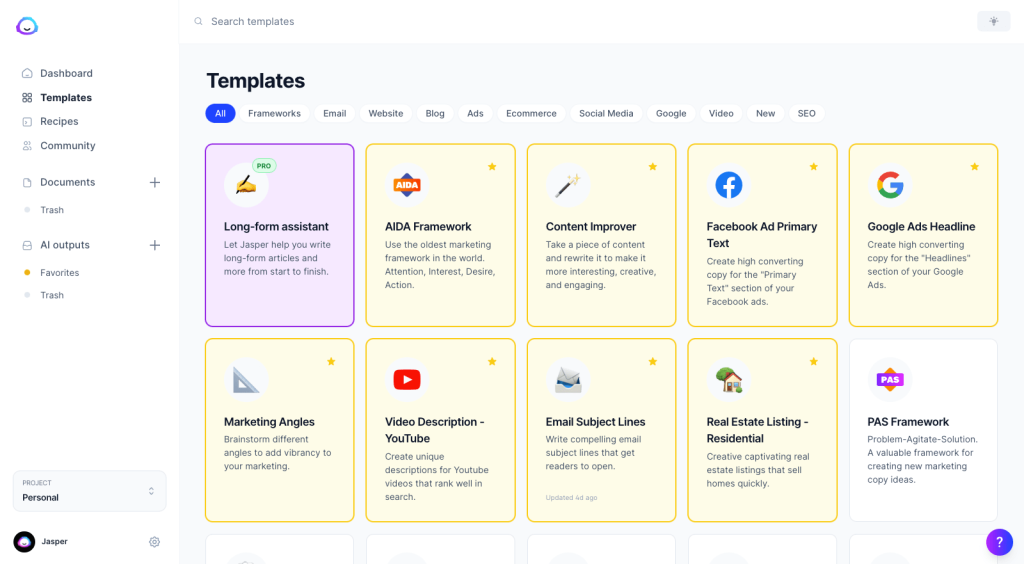
Copy.ai is an AI-powered tool built specifically for marketers and copywriters. It helps create various marketing materials such as social media content, ad copy, blog posts and videos by generating relevant content based on user inputs. All you need to do is input the desired inputs or ideas in brief with some examples or descriptions of the nature of your target audience/market.
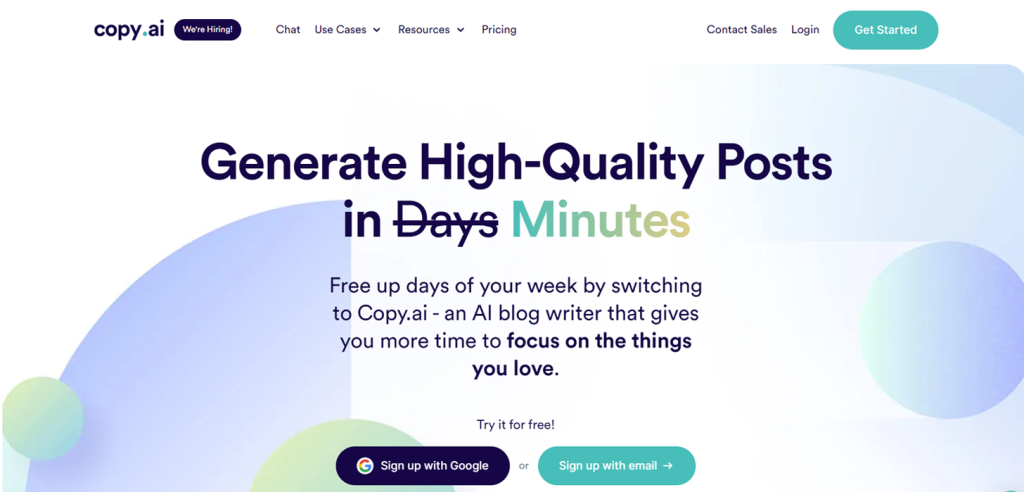
Rytr.me is another popular AI writing tool that uses natural language processing (NLP) to generate high-quality content instantly. It offers features such as summarization of any given research paper or article. Another interesting feature it boasts is collaboration with team members by assigning specific tasks where multiple experts can work together in real-time while utilizing Rytr’s powerful automation capabilities.

Peppertype.ai enables users to create engaging content through its Natural Language Generation (NLG) capabilities. This tool helps users quickly generate engaging content by providing compelling introductions to topics & subject areas they wish to cover along with suggestions for headers and sub-headers which saves time whilst enriching their textual outcome quality considerably.
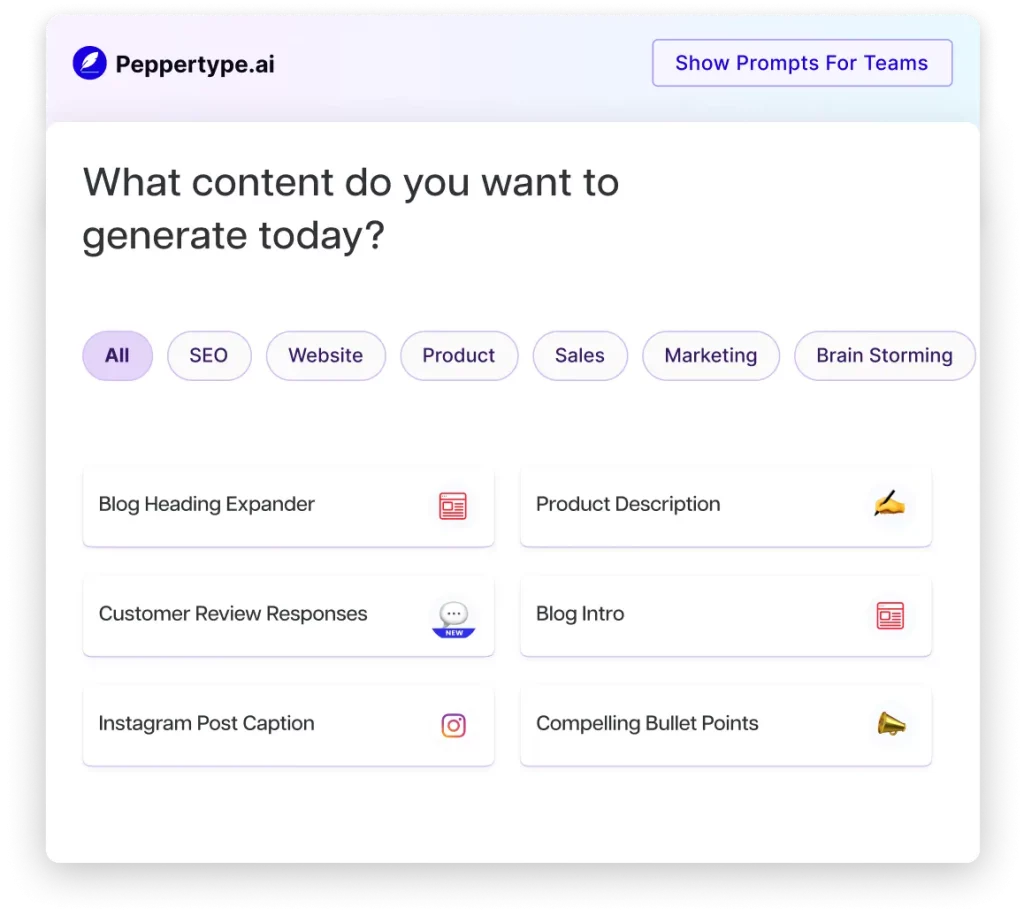
These tools are all designed to make it easier for businesses and individuals to quickly produce high-quality written content without having to spend too much time researching or writing articles. They allow users to focus more on their core business or skill while maintaining a consistent quality of writing and communication.
However, it’s important to note that these tools are like paintbrushes in the hands of an artist. While they can help improve productivity and produce good written material, AI-driven writing tools cannot replicate human creativity and expertise in terms of tone, emotion and critical thinking. Therefore, these tools work best when they strive to assist human writers rather than replace them altogether.
Advantages of AI Writing
AI-powered writing tools come with significant benefits that can make individuals or businesses more competitive by cutting down on time spent reworking texts, allowing for greater consistency across documents, improving language accuracy and supporting a team approach to content creation.
- One key advantage of AI writing technology is improved productivity. These tools are designed to take away tedious processes such as researching topics or even spending hours drafting a single article. With an AI writer at hand, businesses can easily compile insightful content that meets their requirements in no time. The AI writer d’es not need any breaks and can tirelessly churn out articles day in day out which helps organizations plan their marketing strategy better while refining & optimizing existing workflows.
- Another advantage is the enhanced level of consistency which AI-generated text affords readers, as machines adhere strictly to grammatical rules and rules of syntax unlike human writers whose errors may be overlooked during revision. This allows businesses to maintain a certain standard level when generating reports, emails, social media posts or any other form of written product.
- However, some view this consistency as reason enough for caution against the use of these tools whereby a series of uniformed copy carries the risk of being less interesting if it’s “too perfect”. What if everyone just starts churning out same sentences with perfect grammar? Unique selling points (USPs) and storytelling matter. A business that achieves a good balance of human creativity and AI writing capabilities would be the perfect choice.
- AI writing tools also heighten creativity and language skills. They help people who struggle with writer’s block or uninspired days. Additionally, the best writing AIs maintain a learning process, where daily sessions can improve on language accuracy and expressions, ensuring that you write better texts in less time as compared to traditional methods without such practice.
Enhanced Productivity and Consistency
One of the significant ways in which AI writing technology can benefit writers is by increasing productivity and ensuring that their content is consistent. With AI writing tools, writers can produce high-quality content faster and more efficiently than ever before.
For instance, an AI writing tool like On-Page.ai’s Stealth Writer can generate an entire article in just a few seconds, which would take an average writer several hours to produce. With such automated tools, writers have more time to focus on other essential aspects of content creation, such as research or strategy development.
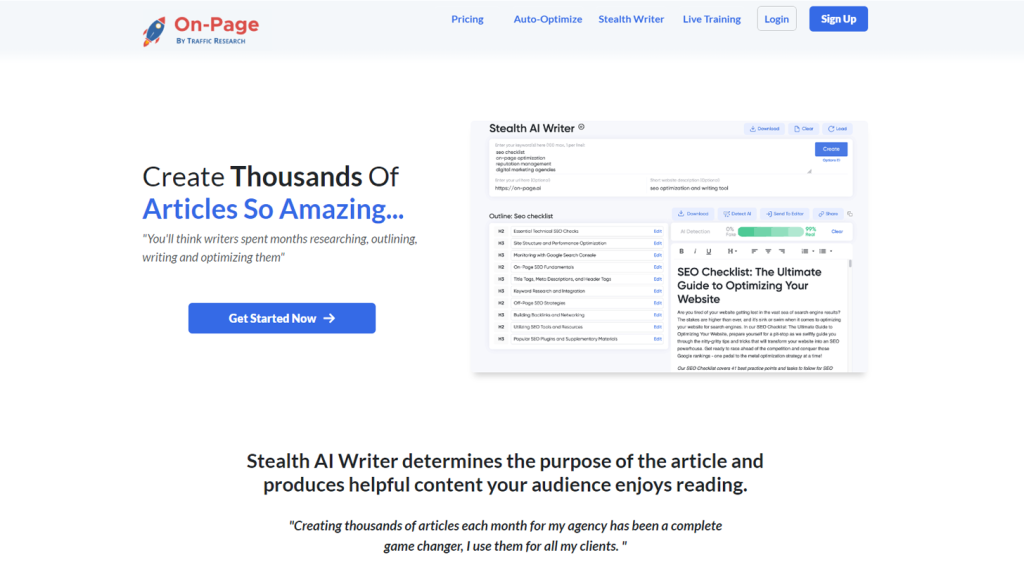
Moreover, AI writing tools provide writers with consistent output, eliminating human error and ensuring that all content meets a certain quality standard. Automated tools help avoid mistakes associated with formatting errors or spelling mistakes. AI writing tools are programmed to ensure that there are no grammatical or spelling errors and that the language used is consistent throughout the text, which also ensures that it ranks better in search engines.
Some might argue that if machines force humans out of work for completing tasks like writing blog posts etc., it may lead to an extended period of unemployment during which people may not be able to afford the luxury of having access to such technological advancements. However, this kind of thinking assumes a static economy where new jobs cannot be created to replace those lost due to automation. The truth is that as society embraces these innovations, new jobs arise as well. The demand for workers who can build and manage such systems is huge, and requires a combination of technical skills as well as soft skills like communication abilities.
That being said, let us move on to discussing how AI writing technology also plays a vital role in improving creativity and language skills.
Improved Creativity and Language Skills
AI writing tools are not just providing benefits of speed and consistency but are also improving the creativity and language skills of writers. Smart AI systems are designed to help authors extend beyond their usual limits, introducing new ideas while simultaneously adhering to the established context of respective companies.
It is like having a brainstorming partner who offers insights and solutions you could have never thought about. AI writing tools can be used to suggest fitting metaphors or relating terms, which add depth and value as well as air of novelty to your content.
Moreover, some AI writing tools like On-Page.ai Content Editor offer personalized recommendations for content improvement based on machine learning algorithms that measure things such as readability, keyword density, engagement metrics, and other factors that help optimize digital content overall. In doing so, they provide feedback on areas where improvement be necessary, suggesting ways to build better connect with the target audience by analyzing what has worked and what hasn’t worked in the past.
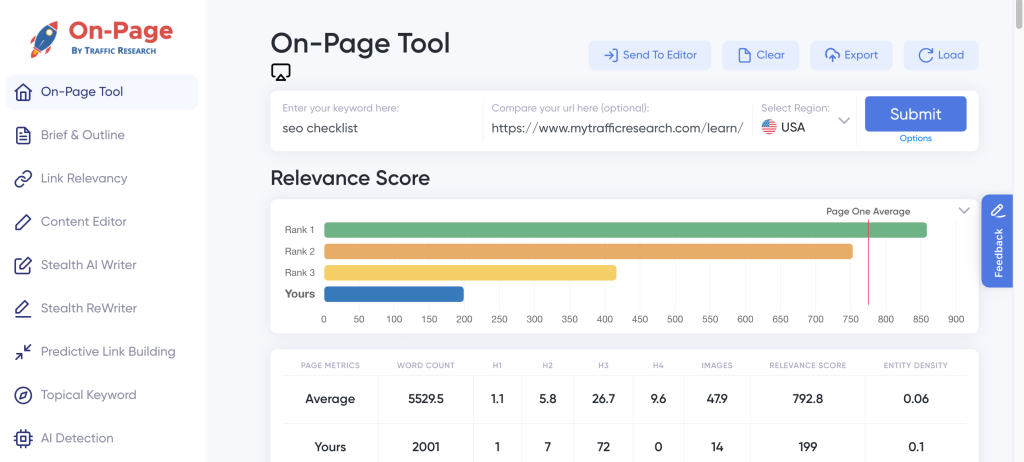
Many writers might shy away from adopting creative ideas or unconventional structures when composing pieces for their clients because they may not want to risk getting a negative response from their audience. Here’s where AI writing technology comes in – it enables them to experiment with novel themes and styles without putting career at risk.
On the other hand, some would argue that this may lead to over-reliance on AI writing technology by content creators who might stop developing their creativity due to over-automation of tasks using AI technology. This is not necessarily true since many individuals use automation technology not as a replacement for hard work but rather an inclusive tool in achieving desired results faster and more accurately.
But just like any technological advancement has limitations, we will discuss how AI writing technology faces its obstacles as well as possible solutions.
Applications and Use Cases

AI writing technology has proven to be useful in various applications, industries, and use cases. From creating emails, reports, proposals, marketing copies to generating ideas for blog posts and social media content, AI writing tools like Stealth Writer have been designed to make writing tasks more manageable and less time-consuming.
In the marketing industry, AI writing tools have been used to generate landing pages, product descriptions, and advertising copies that grab users’ attention. With the help of AI-powered language analysis tools, businesses can identify what works best across different customer segments and tailor their message accordingly. Companies like Shopify Plus have started using NLP-enabled AI writing platforms like Jarvis (formerly Conversion.ai) to write persuasive ad copy that produces better ROIs than human-written ads.
Another industry where AI writing is becoming increasingly popular is journalism. A recent study by OpenAI revealed that 40% of all news articles could be generated using GPT-3-based language models with minimal human intervention. In practice, journalists are now using content generation tools powered by AI algorithms to create news stories faster and more efficiently than ever before. They are also freeing up time for themselves to focus on more in-depth investigations.
One way to understand the role of AI writing in the workplace is to think of it as a virtual assistant that helps you organize your thoughts and brings structure into your drafts. Imagine having a smart tool that can save you hours of typing by suggesting an outline for your next report or email based on previous templates you used before.
Furthermore, AI writing can assist content creators from various backgrounds in brainstorming new ideas that they haven’t thought about previously. These ideas can then serve as inspiration for new pieces of content such as videos, podcasts or whitepapers.
Some critics argue that using machines instead of humans to create digital content may lead to a lack of emotional connection with the audience. In response, it is essential to understand that AI writing is not a replacement for creativity or human touch but rather a tool that can support and enhance it. While AI can use natural language processing to create compelling headlines or call-to-actions, it still cannot replace a human creator’s ability to build rapport through storytelling.
Therefore, while the applications of AI writing are vast and diverse, there are still some limitations and challenges that need to be addressed.
- Research conducted in 2020 shows that using AI writing tools can increase writing speed by up to 40% compared to traditional methods.
- According to a survey conducted in 2021, nearly 80% of marketing professionals believe that AI writing tools will change the way content is created and optimized within the next five years.
- In a study published in 2019, it was found that AI-based writing applications are reaching human-like capabilities with an accuracy rate of approximately 90% in grammar and punctuation correction tasks.
Overcoming AI Writing Limitations and Challenges
Despite the significant progress made in the field of AI writing, we have to recognize that there remain a few limitations and challenges to overcome before we realize its full potential.
One major challenge of AI writing technology is its inability to differentiate between context-specific phrases. For example, idioms or puns that are understood by humans within certain cultural contexts can be challenging for machines to comprehend.
Misinterpretation can lead to awkward phrasing or inappropriate language in generated texts. Human writers could solve this problem by editing the text produced by these machines; however, this would require time and attention from editors who may find themselves overwhelmed by large volumes of generated content.
Another challenge related to AI writing technology is about legal implications concerning ownership and authenticity.
There have been many debates in recent years about whether AI-generated texts should be subject to copyright laws or whether they should be considered public domain because they were created using algorithms instead of human creativity. On the other hand, some argue that it is vital for creators to receive intellectual property protection from their creations, regardless if they are generated using machines.
Another way to think about this debate is between two culinary experiences: cooking versus baking. While cooking allows for improvisation when creating dishes with ingredients readily available, baking requires a strict recipe to follow for successful outcomes. In the same light, AI writing tools may perfect content generation algorithms but require stricter guidelines in using pre-defined text structures that only solve known problems.
Despite these challenges and limitations, AI writing is an advanced technology that promises enormous potential in enhancing productivity, improving language skills, and creating better communication between writers and their readers. It’s safe to assume that, going forward, AI will become an increasingly essential tool for anyone who wants to produce online content more efficiently and with better results. Register to the exceptional writing tools available on On-Page.ai and elevate your writing experience.
Common Questions and Explanations
What types of content can be generated using AI writing technology?
AI writing technology has advanced significantly over the years, enabling it to create a wide variety of content types. Some examples of content generated using AI writing technology include:
1. News articles – AI-powered news writing bots have been used by major media outlets such as The Washington Post and Reuters to generate news stories quickly and efficiently.
2. Product descriptions – Online retailers are increasingly turning to AI-generated product descriptions to save time and improve accuracy.
3. Social Media Posts – Many businesses are using AI to generate high-quality social media posts that align with their brand voice and messaging.
4. Emails – With the help of AI text generators, personalized emails can be created with less input human intervention.
In addition, AI-powered content creation tools can be used for blog posts, whitepapers, eBooks, and more. According to a study conducted in 2022 by Grand View Research Inc., the global AI content creation market was valued at $1.8 billion USD in 2021 and is expected to reach $16.5 billion USD by 2028 (Grand View Research Inc., 2022). This suggests that the use of AI writing technology will continue to grow in popularity across various industries and sectors.
What industries or fields could benefit the most from AI writing technology?
The potential applications of AI writing technology are vast and wide-ranging. Some of the most promising fields that could benefit from AI writing technology include marketing, journalism, E-commerce, education, and healthcare.
In the marketing industry, AI writing technology can help with content creation for social media campaigns, email marketing, and even website copy. According to Forbes, AI-powered content has an engagement rate that is 73% higher than non-AI generated content. AI writing technology can also provide personalized recommendations based on customer data, making it easier for marketers to target specific audiences and increase sales.
In journalism, AI writing technology can help journalists generate news articles faster and more accurately, freeing up time for them to focus on investigations and interviews rather than simple reporting. According to the Associated Press (AP), their automated journalism platform called Automated Insights generated 4 billion stories in 2017 alone.
In E-commerce, AI writing technology can generate product descriptions and reviews that are tailored to individual customers’ preferences. This personalized approach can increase customer engagement and drive sales. A study conducted by Chatbots Magazine found that 67% of consumers worldwide used chatbots for customer support in 2018.
In education, AI writing technology can assist students in improving their writing skills through automated feedback on grammar, vocabulary usage, and sentence structure. This can save teachers time on grading while still providing valuable feedback to students.
Finally, in healthcare, AI writing technology can assist doctors in generating patient reports quickly and accurately. This technology can also help with medical research by analyzing large amounts of data quickly. According to a study published in Plos One journal in 2020 about “AI-generated articles outperformed human-written ones” in terms of accuracy.
In conclusion, various industries and fields have begun implementing the use of AI writing technology because of its impressive results in multiple applications such as generating personalized content in E-commerce or enhancing medical research reports’ accuracy all while saving significant time and resources.
How does AI writing differ from traditional human writing?
AI writing differs from traditional human writing in several significant ways. Firstly, AI-powered writing technology enables the creation of large volumes of content at unprecedented speeds. According to a study by OpenAI, their language engine GPT-3 can generate up to 4.5 billion words per day, surpassing the output of most human writers by orders of magnitude.
Secondly, AI writing technology has the capability to analyse vast amounts of data and create insights that would be unfeasible for a human writer. This means it has tremendous potential to transform industries as diverse as healthcare, business and sports.
Thirdly, automated writing systems process large amounts of data into relevant and accurate content without bias or subjective interpretations unlike humans who are prone to unintended bias. It’s worth noting that while this is a benefit in terms of accuracy and objectivity, it could also pose a risk if the data used to train the AI models is biased in turn leading to algorithmic biases.
Finally, AI writing requires little to no upkeep or management beyond its initial deployment or training which greatly cuts costs and time compared to employing a whole team of technical writers.
In summary, AI writing offers speed, greater insight capabilities, unbiased analysis with reduced costs when compared with human writers. However, there’s still lots more (like ethical implications) that we need to carefully consider as automated writing begins making its way into the mainstream market.
Are there any ethical concerns surrounding the use of AI writing in journalism or marketing?
Yes, there are several ethical concerns surrounding the use of AI writing in journalism or marketing. One major concern is the potential for AI-generated content to perpetuate biases and stereotypes due to the algorithms used by these technologies. In 2019, a study published by The Markup found that Google’s language model was more likely to associate female names with stereotypically feminine words and male names with stereotypically masculine words.
Another concern is the possibility of AI-generated content being used to spread misinformation or propaganda. In 2020, OpenAI released GPT-3, a highly advanced language model that can be used to produce persuasive and convincing text, including fake news articles and propaganda.
Moreover, the use of AI writing raises questions about authorship and attribution. Should an AI-generated article be attributed to a human writer, or should credit be given to the algorithm or company behind the technology?
Finally, there are also potential job loss implications as more companies turn to automated writing technologies instead of human writers. According to a report from Forrester Research, automation has the potential to eliminate up to 29% of jobs in content creation and content management.
Given these concerns, it is important for companies and journalists using AI writing technologies to prioritize transparency and accountability in their content creation processes. It is also crucial for regulators and policymakers to develop guidelines and regulations around the use of these technologies in order to promote ethical practices and protect consumers from harm.
Can AI writing replicate the same level of creativity and nuance as human writers?
AI writing technology has evolved greatly in recent years and has been used in various fields, including journalism, marketing, and content creation. However, the question remains: Can AI writing replicate the same level of creativity and nuance as human writers?
The short answer is no. While AI can generate content quickly and accurately, it lacks the ability to think creatively and produce original work. AI models are trained on existing data and patterns, so they are limited to what they have seen before. They cannot come up with entirely new ideas or take creative risks.
In fact, many studies support this argument. A 2018 survey by Oxford University found that only 8% of respondents believed that AI robots could create a novel story without human intervention. Another study published by Gartner in 2020 shows that despite significant advances in natural language processing (NLP) technology, AI-generated content still lacks authenticity and emotional depth compared to content created by humans.
Of course, this is not to say that AI cannot be useful for certain types of writing tasks. For example, automated software can assist with keyword research for search engine optimization (SEO) or generating basic news stories based on data inputs.
However, when it comes to capturing the nuance of human emotions and creating truly engaging storytelling experiences, human writers reign supreme. As such, while AI writing technology may continue to improve over time, it is unlikely to replace the creativity and intuition unique to human writers anytime soon.

